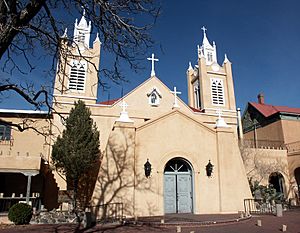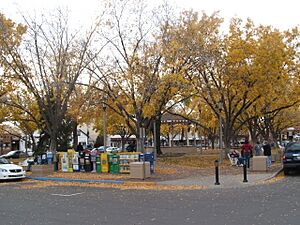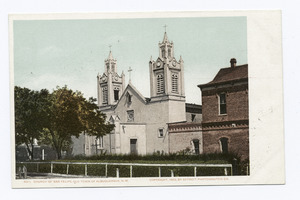Old Town Albuquerque facts for kids
Old Town is the original historic part of Albuquerque, New Mexico, in the state of New Mexico. It was started in 1706 by Governor Francisco Cuervo y Valdés when New Mexico was a Spanish territory. Today, Old Town is known as the Old Albuquerque Historic District and is protected because of its history.
The area has about ten blocks of old adobe buildings. These buildings surround the Old Town Plaza. On the north side of the plaza, you'll find San Felipe de Neri Church. This church was built in 1793 during the Spanish colonial period.
Old Town is a very popular place for visitors. It has many restaurants, shops, and art galleries. You can also visit the Albuquerque Museum of Art and History here. Nearby are the New Mexico Museum of Natural History and Science and Explora, a fun science center. Old Town is also famous for its beautiful luminaria displays during the holiday season, especially on Christmas Eve.
What Old Town Looks Like
Old Town covers an area of about 0.8 square miles (2.1 km²). It is generally located between Rio Grande Boulevard, Mountain Road, 19th Street, and Central Avenue.
The heart of Old Town is the Old Town Plaza. It is surrounded by one- and two-story buildings. Spanish leaders often designed their towns with a central plaza. You can see this design in other New Mexico cities like Santa Fe and Taos. The land around Old Town used to be farmland, watered by special irrigation ditches called acequias. While much of it is now developed, some areas to the north and south still use these traditional farming methods.
Old Town's Story
The Spanish town of Alburquerque was founded in 1706. Governor Francisco Cuervo y Valdés started it. He said the new town had 252 people, with streets, a plaza, and a church. This was all planned according to Spanish rules for building towns. The town was meant to serve the Spanish and Pueblo communities already living along the Rio Grande. It also served as an important stop on the Camino Real de Tierra Adentro, a historic trade route.
Like other Spanish towns, Albuquerque had a central plaza. Houses, government offices, and a church were built around it. For many years, people only stayed in the plaza area on Sundays. The rest of the week, they worked on their farms. By the late 1700s, more people started living around the plaza all the time.
In 1821, control of Albuquerque and New Mexico passed to Mexico. This happened after Mexico won its independence from Spain.
During the Mexican–American War in 1846, U.S. forces arrived. They were led by Stephen W. Kearny. The U.S. took control of New Mexico without a fight. Kearny came to Albuquerque in September to raise the U.S. flag. He also had local people promise loyalty to the U.S. Army.
The U.S. Army set up a post near the plaza. This brought more goods and people to the town. By 1860, Albuquerque had 1,608 people, with about a third being soldiers. During the U.S. Civil War, Confederate troops took over the town in March 1862. But they had to leave after losing supplies in the Battle of Glorieta Pass. There was a small fight in Albuquerque as the Confederates retreated. For most of its history, Albuquerque remained a quiet farming community.
In 1880, the Atchison, Topeka and Santa Fe Railway arrived. The railroad built a station about 2 miles (3 km) east of the plaza. This led to the creation of a new town, called "New Albuquerque." This new area quickly grew thanks to the railroad. It became the City of Albuquerque in 1891.
The original town, now called Old Albuquerque, started to decline. Businesses and important buildings moved to the new town. By the 1930s, very few businesses were left around the plaza.
However, in the 1940s, people began to appreciate Old Town's history. The Old Albuquerque Historical Society was formed in 1946. Old Town became part of the city in 1949. This brought modern improvements like paved streets. Since then, Old Town has become a popular tourist spot. Many of the old adobe houses are now shops, restaurants, and galleries.
The Plaza
Old Town Plaza has been the center of Old Town since the city was founded in the 1700s. It used to be larger but was made smaller by the late 1800s. In the 1850s, the U.S. Army put up a 121-foot (37 m) flagpole in the middle of the plaza.
The adobe wall around the plaza was replaced with a wooden fence in 1881. Then, a stone wall was built in 1937. These new walls and a bandstand were not popular. They were removed just eleven years later by local efforts. The historical society then helped build a new bandstand and added new plants. They also put in 16 iron benches bought from Chihuahua, Mexico.
At the east end of the plaza, you can see two replica cannons. These are copies of M1835 mountain howitzers. During the Civil War, Confederate soldiers buried eight cannons near the plaza in 1862. They did this to keep them from the Union army. The cannons were found in 1889. Two of them were displayed in the plaza. Later, they were moved to the Albuquerque Museum of Art and History. The replicas you see today took their place.
At the west end of the plaza, there is a display of different flags. These flags have flown over the city throughout its history. They include the flags of Spain, Mexico, and the United States. A Confederate flag was also displayed for a short time, but it was removed in 2015.
Buildings
Most of the historic buildings in Old Town were built between 1870 and 1900. Some are even older. Only one building, San Felipe de Neri Church, is confirmed to be from the Spanish colonial period.
Over the years, many buildings were changed for modern shops. Sometimes, old architectural details were changed to fit a more "ideal" style. However, other buildings have been kept in their original state.
Five buildings in Old Town are listed on the National Register of Historic Places. This means they are very important historically:
- Salvador Armijo House, built around 1840
- Charles A. Bottger House, built in 1912
- Our Lady of the Angels School, built in 1878
- San Felipe de Neri Church, built in 1793
- Antonio Vigil House, built in 1879
Images for kids









